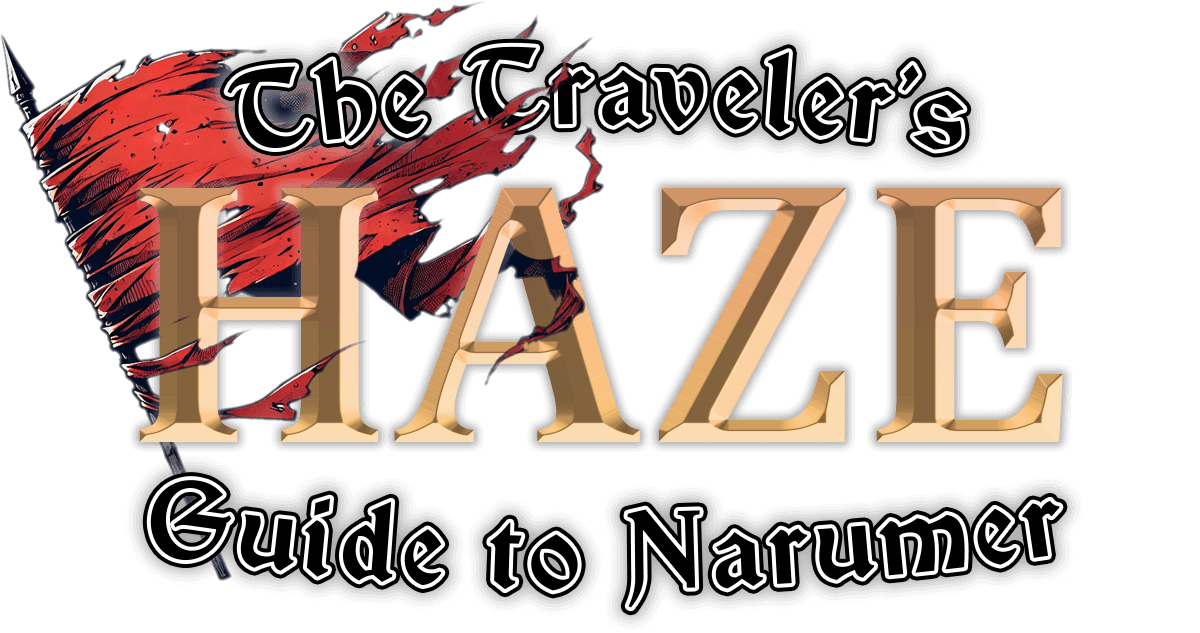
Welcome to the Traveler's Guide to Narumer! Our goal is to help you hit the ground running by highlighting essential information about classes, races, and abilities.
This guide has streamlined the details to keep the focus on what's most important for newcomers. You may also prefer to just dive into the articles on the left-hand side, if that's more your style.
With that out of the way, let's get into how you can join the world of Haze: Saltborne and create your own story!
If you intend to go in blind without reading the guide, that's fine! But please acquaint yourself with the rules first if you intend to! It is your obligation to do so.
¶ 
Haze: Saltborne is guided by a set of 6 core pillars:
- Fun: Our community is all about fun and enjoyment. We want you to have a great time with Haze.
- Permadeath: Death is integral to every great story. In Haze, there are no respawns or second chances.
- Immersive Roleplay: When you enter Haze, you step into a new world. We take RP seriously, keeping casual chatter to a minimum.
- Player-Driven: While our DMs maintain and enrich the world, Haze is your story. All stories and organizations are purely player-driven.
- Low-Level, Low Magic, Slow Progression, High Fantasy: Expect a challenging environment without overpowered items.
- Hard: This is a tough server with permadeath, low levels, and low magic. The island is unforgiving, as you'll soon discover.
¶ 
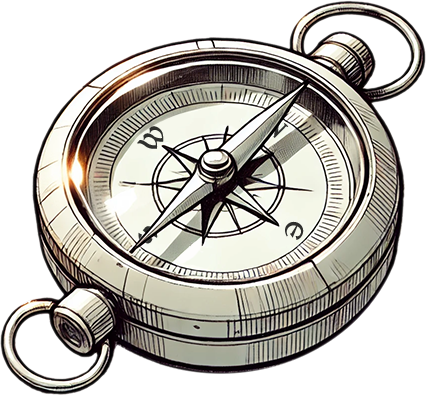
Haze: Saltborne's setting makes it easy for new roleplayers and seasoned lorehounds alike to quickly get settled in.
The story of Haze: Saltborne unfolds on the mysterious island of Narumer. The past lore aligns with the Forgotten Realms up to the year 1385 DR, with the following changes:
"As Cyric and Shar attempts to murder Mystra, a ripple echoes across the world - A Seal is broken, a thread of fate is pulled from the weave of reality..."
This is the point where canonical Faerûn lore branches out, effectively preventing the Spellplague of ever happening. Mystra’s fate remains unknown, although her prayers as well as the other Divine’s appears to be answered still...
Nothing of significant importance has happened since 1385 DR. The date is now 14XX DR and you have washed ashore.
Narumer is an uncharted island unknown to anyone in Faerûn. Your character's journey begins with a shipwreck, originating from the mainland of Faerûn. Whether they embarked from the Sword Coast or were traveling across the Sea of Stars does not matter!
Haze: Saltborne offers a low-level, low magic, and slow progression experience. Narumer is an unforgiving island. Every step requires careful planning and a keen mind to survive the many lurking dangers.
¶ 
Once the veil to Narumer is crossed and a character washes upon the sandy beach of the Island, they will find their magical connexion to be different. This ancient island is not governed nor affected by The Weave the same way their land of origin may be. Here, magic is a fickle thing, old and exhausted. It is a finite energy, and with each conjuring, each miracle and each pact called upon, this energy trickles and fades further and further. This remains true for each source of magic, be it the structured and precise formulas from a Wizard’s grimoire, the raw manifestation of a sorcerer’s bloodline, the plead of a faithful Priest being granted by the divine, or the soothing harmony behind a Bard’s melody. Magic is fading.
Prayers, although distant and muffled, are still answered by those with the gift to call for it. Priests of various walks of life will know that something is indeed different. Yes – Their patron god still answers their prayers, but it does not feel as it might have before. Granted miracles bears a distinct taste, and rings of a specific note – They all remind you of the island itself, the way the sun shines on the sandy shores, the smell of salt and seaweed that permeates the air, and a fleeting dread that in time, the source of it all will inevitably falter and wither away…
¶ 
Religion is as diverse as there are believers. While characters may be used to exceptionally rigid precepts and domains, with churches encroaching on one another, The Divine on Narumer is not exempt from the withering of magic and in doing so, characters bound by the divine will realize that their patrons may have much less defined spheres of influence – as if will, intent and faith intertwined with one another, and spread thinly over all matters of life. A mist, or Haze, if you will…
In addition to completely ignoring the Spellplague of 1385 DR, players may expect severe differences in a Patron’s “Canon Lore”, which for obvious reasons will not be disclosed openly. “Events” and “facts” from official Faerûn literature may be true, or not. Keep in mind that almost nothing is “common knowledge”, especially when regarding matters of faith.
¶ 
Like any other campaign or server, character creation begins at the character creation screen. Here you'll select from various races and classes, including Haze's unique custom options.
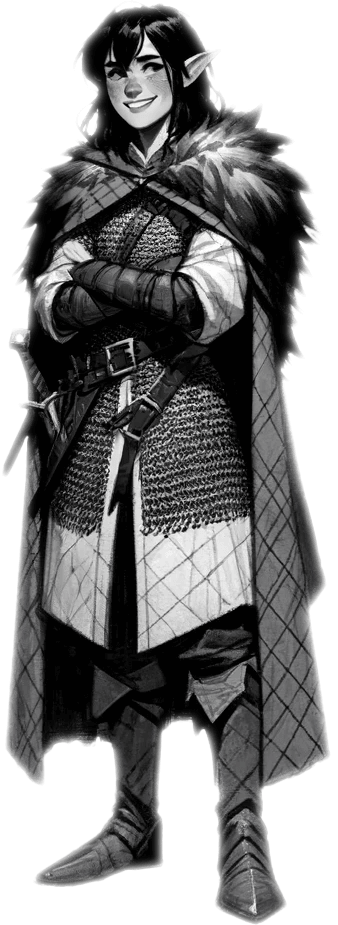
¶ 
There are a number of classes available to you right at the start. Many of the base classes have custom changes, which you can read about on the character classes page.
Some classes may appear in magenta text—these are locked behind Eminence Points, a feature detailed later in this guide. As a new player, you won't have access to these classes yet, so you can skip over them for now.
¶ 
Initially, you can select from the base races of NWN: EE before entering the server. Once you spawn into the game for the first time, additional sub-races become available in the OOC Area, via the Character Setup Mirror.
You can familiarise yourself with the various subraces on the races and subraces page.
*Like classes, some subraces are locked behind Eminence Points.
¶ 
In Haze, most feats are available, but some have been adjusted to suit the game's setting and balance. Additionally, there's a wide array of new, custom feats for all classes. You can read about all the changes and new feats on the feat changes page.
¶ 
Similarly, Haze features many changes to skills. These skills and their changes are covered in the skill changes page. Most notably, Haze has reworked the Lore skill into separate knowledge skills, Spellcraft now has further uses for spell recovery, and Animal Empathy is completely reworked.
¶ 
After creating your character, you will spawn in the OOC area where you can make final modifications to your character.
- The OOC area has an appearance mirror for last minute modifications.
- Speak to Eminar to browse the EP shop, where you can spend EP(covered later in this guide) to purchase items before you spawn into the world.
¶ 
Other characters need some sort of way to identify you. After all, strangers can't be expected to know your name when you first meet them.
To set your default name and description, use the !desc command, which brings up an interface which will allow you to change these.
- Naming other characters: Players can assign names to other characters they meet by using the
!name <name>command and clicking the character. - Default name: In Haze, all characters have a default name that is visible to everyone else when they first interact.
- Note: Do not use the default name to set an actual name. It should only be treated as a short appearance descriptor.
- Character Description: Your character description is show when other players examine your character.
- Tip! Try to keep your character descriptor as objective as possible. Use it to describe things like your characters appearance, voice, and mannerisms. Avoid infering subjective feelings onto the reader, or writing backstory.
¶ The Test Area
Additionally, there is also a portal to the Character Test Area behind you when you first spawn in. Here you can test any character build you like, up to level 5.
Note: Entering the portal to the Character Test Area will mark your character as a test character. Test character's are deleted automatically when you log out.
¶ Finalizing
When you are ready to enter the world, proceed to the world portal(s) at the end of the OOC area.
¶ 
- (Tip!) Backgrounds: Choosing a background gives your character a crafting book and crafting knowledge. You can roleplay the reason for your crafting background as you wish. Backgrounds allow you to start at level 2 in any crafting skill for free.
- (Tip!) Knowledge skills: The Knowledge skills for arcane, nature, history, religion and architecture all have their uses, even outside of RP scenarios. Don't dismiss these skills as pointless.
- (Tip!) Languages: Based on your character's intelligence, you receive language points to spend on additional languages.
- Major/Racial Languages: Cost 2 points.
- Minor Languages/Dialects: Cost 1 point.
- Locked Languages: Some languages require Eminence Points to unlock.
- After unlocking a language, use
!lang <language>to set it to your secondary, and prefix your message with<to send text in that langauge.
- Attribute scores and character restrictions:
- (Tip!) Consider your STR carefully: A low STR score will make it strenous to carry many items. Unless it's what you're going for, avoid STR scores under 10.
- Roleplay comes first: Even with the above tip, don't get hung up on effectivizing your ability scores down to the last minute detail. Fighters can be weak, and Bards can be uncharismatic. Play what appeals to your personal fantasy the most.
- Character restrictions:
- Important: Your character cannot have more than one attribute below 10, unless you are a Half-orc, in which case you can have two attributes below 10.
- Important: Haze has multiclassing restrictions. There are no restrictions for multiclassing within your first 2 levels. However, multiclassing after level 2, or picking a third multiclass at any subsequent level requires DM team approval. Read more here.
- Note: Characters with an INT score of 8 or lower usually struggle to articulate advanced thoughts, and may not be able to speak "normally". Keep this rule of thumb in mind during character creation and roleplay.
¶ 
Crafting stands at the heart of gameplay in Haze: Saltborne, showcasing a unique and intricate system. Potions, armor, weapons, and useful adventuring equipment can all be crafted to enhance your journey.
In Haze, crafting professions are categorized into two types: primary and secondary. All primary professions can craft reagents essential for other professions, creating an interdependent system where each profession supports the others in producing finished items.
¶ Crafting Levels & ECL
To level up your crafting skill, you require CXP. Every hour, +1 CXP gets added to your CXP Pool. By default, you can have a maximum of 60 CXP saved up. This cap can be increased on certain classes or with certain feats. Crafting items will consume CXP and in turn level up your crafting ability.
Each crafting skill is linked to an attribute, and your attribute modifier boosts the skill without changing its level. This is called the Effective Crafting Level (ECL).
Example: A character with level 2 blacksmithing and a +3 CON modifier has an ECL of 5. The CXP needed to reach level 3 remains the same, but their skill functions as level 5.
¶ Multiple Professions
You can learn multiple primary crafts, but there are drawbacks. Most notably, you lose the ability to create masterwork items, and the more primary crafts you spread your skills across, the harder each becomes overall.
For a detailed summary, visit the page on Crafting.
Note: Taking secondary crafts incurs no penalties on your primary crafting!
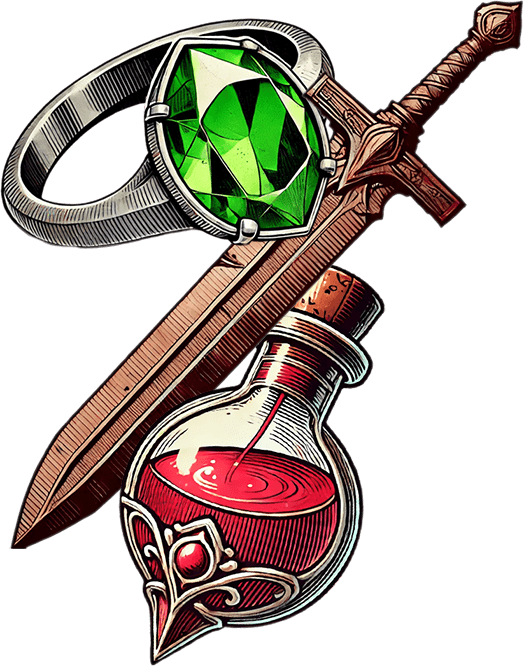
¶ 
 (INT) Alchemy - potions, dyes, reagents, useful utility
(INT) Alchemy - potions, dyes, reagents, useful utility (CON) Blacksmithing - armour, weapons, ammunition, upgrades
(CON) Blacksmithing - armour, weapons, ammunition, upgrades (DEX) Leatherworking - armour, clothing, furniture, upgrades
(DEX) Leatherworking - armour, clothing, furniture, upgrades (WIS) Tinkering - jewelry, containers, traps, misc.
(WIS) Tinkering - jewelry, containers, traps, misc. (DEX) Woodworking - furniture, bows, ammunition, staves and wands
(DEX) Woodworking - furniture, bows, ammunition, staves and wands
¶ 
 (WIS) Cooking - food, drink and sweets!
(WIS) Cooking - food, drink and sweets! (Survival Skill) Survival - rudimentary tools, weapons and clothing. Survival tasks such as lighting fires or setting up tents.
(Survival Skill) Survival - rudimentary tools, weapons and clothing. Survival tasks such as lighting fires or setting up tents.
¶ So? How do I actually craft?
Crafting in Haze requires five essential components:
- A relevant crafting book with the desired recipe.
- A crafting station appropriate for the item you wish to create.
- All necessary materials for the item.
- Adequate skill level in the relevant crafting discipline.
- Sufficient Crafting Experience Points (CXP).
¶ 
Let's dive into the details! Here is a quick example on how a tinkerer would go about crafting a Silver Amethyst Ring.
¶ 1. Ensure you have a recipe book
To craft an item, we need blueprints notebook for tinkering, since tinkerers make jewelry.
¶ 2. Find out the materials required
Browse your recipes simply by using the book on itself. In the screenshot below, we can see that Silver Amethyst Ring requires 1x polished amethyst, 1x silver ingot, and 1x coal. The number next to it represents the ECL required to craft it at Normal difficulty.
¶ 3. Find the appropriate crafting station
Locate the appropriate crafting station. In this example, the Tinkering Station.
¶ 4. Craft the item
- Place all the required items into the station's inventory to begin crafting. Close the inventory. The crafting dialogue will automatically open. If it does not open, you can use the blueprints book on itself to open the crafting menu manually.
- Find your item in the list. In this case the item falls under the categories Tier II, Jewelry.
- Select the CXP you wish to invest into the initial craft. Some crafts require more CXP, depending on the product, or the difficulty of the craft.
3.1. If the item is eligible for masterworking, you can choose to do so here. - Craft the item.
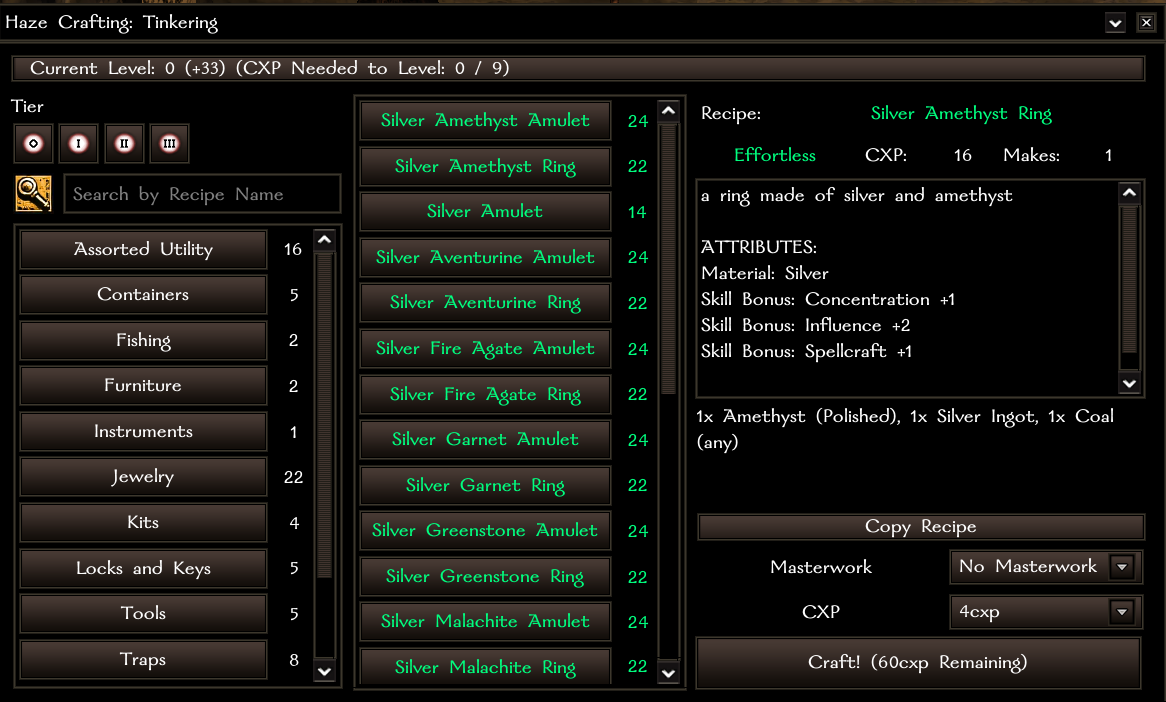
After the item finishes crafting, open the workstation again to find your finished item.
¶ Effortless, Normal, Very hard, what does it all mean?
Different recipes in Haze come with varying levels of difficulty. You can attempt to craft any item, provided its difficulty isn’t listed as 'impossible.' However, be aware that crafting more challenging items requires more Crafting Experience Points (CXP). Additionally, equipment crafted from higher-difficulty recipes may incur maluses, reflecting the complexity of the task.
You can read more about crafting on it's own dedicated page: Crafting
¶ 
Haze: Saltborne is a low-level, low-magic setting with unique spellcasting systems for Wizards and Sorcerers.
Other classes still follow standard casting rules, receiving a set number of casts for their spells per day(long rest).

¶ 
Wizards use a grimoire and a receive a non-removable component pouch upon creation.
- Spell scribing: Wizards can learn more spells by adding scribed spell scrolls to their grimoire.
- Component-based casting: Every spell on the wizards spell list should have a component, listed in your in-game grimoire.
- Wizards may cast any prepared spell once per rest for free, without any component. However, doing so will consume the spell slot until your next rest.
- Cast spells by first placing components in the pouch and make a Spellcraft check to cast.
- On success, the used component is spent, but the Wizard keeps the spell slot, allowing more spell casts per day than typically allowed.
- On failure, the spell slot is consumed, but the component is left unused. The slot cannot be used to cast again until the slot is regained through a long rest.
- Some spells have only a % chance to consume a component.
- Some spells have mandatory components that are necessary for ANY caster to cast the spell, these components are usually listed in the spell descriptions.
¶ 
Sorcerers rely on their innate abilities to cast spells, using constitution and essence for spell slot recovery.
- Manifest Bloodline: Regain essence by sacrificing 1 CON.
- Manifest Adaptation: Starting at Sorcerer(3) you can swap sorcerer spells between levels, expending your CXP in the process based on spell levels.
- Spell Slot Recovery: Spend essence to recover spell slots at a 1:1 ratio. (e.g., Level 1 spells cost 1 essence, Level 2 spells cost 2 essence, etc.)
- Cantrip Recovery: Make a Spellcraft roll (DC-16) when casting a cantrip to attempt automatic slot recovery.
- Some spells have mandatory components that are necessary for ANY caster to cast the spell, these components are usually listed in the spell descriptions.
You can read more about the spellcraft system on it's own dedicated page: Spellcraft System.
¶ 
Since Haze is a low-level and slow progression environment, this has also given way to many changes in regards to level progression and XP.
XP can come from a few different sources:
- Creature Kills: Killing creatures and monsters.
- Training Dummies: Grants XP once per 12 real-world hours.
- Hourly Ticks: You receive a small amount of experience each hour for simply staying active.
- DMs: DMs may grant XP rewards for engaging roleplay or impressive feats.
- Eminence Wand: Player can reward each other with XP for exceptional roleplay, once every 12 hours.
- Exploration: Exploring certain areas of world will sometimes grant your party XP.
The point of Haze is not to rush up the levels by optimizing your progress. Going out of your way to farm creatures early and often can hinder long-term progression. XP can only be dropped from any creature a finite amount of times.
Haze encourages smaller, more coordinated parties. Large parties get reduced XP from exploration nodes, and XP from creature kills are spread amongst the party, seeing the greatest return in smaller parties of 4-6 people.
You can read more about progression on it's own dedicated page: Experience & Class Advancement.
¶ HAZE E6 - A D&D Rules Variant for Low-Level Fantasy D&D
Haze features a customized version of the E6 system, a variant of Dungeons & Dragons where level progression halts at level 6. Instead advancement after 6th takes a new form, offering a different type of nuanced and meaningful long-term development.
Once a character reaches level 6 in class levels (ECL modifiers from races do not count toward this), they officially enter E6 status. A +2 ECL race still requires 6 actual class levels before qualifying.
Upon qualifying, you’ll gain access to the E6 Menu. The E6 menu is used to spend Epic XP (EEXP) on things like perks, feats and ability score improvements.
You can read more about progression on it's own dedicated page: HAZE E6 - A D&D Rules Variant for Low-Level Fantasy D&D
¶ 
When a character reaches 0 HP, they enter a 'bleeding out' state. Other players must help to stop the bleeding; failure to do so results in permanent death, and the character enters The Fugue with no return.
- Stopping Bleeding: Use healing spells or Medical Kits. If you don't have a Medical Kit, use the !resupply command to take one from a downed companion.
- Permanent Death: Player deaths are almost never reversed. A DM may intervene if a death is deemed unfair, usually due to player misconduct.
![]()
Being revived from a 'bleeding out' state will impart a near-death debuff on your character, slowing you down and making you very vulnerable for a period of time. It's time to rest up!
You can read more about permadeath on it's own dedicated page: Death System, Permadeath.
¶ Twists of Fate
Bleeding out does not always mean the end is coming.
- Auto-stabilize: When in a bleeding-out state, there is a very small chance that a character may "self-stabilize" and stop bleeding on their own. In Haze, the feat Luck of Heroes increases the chances of this happening.
- Self-stabilize: When in a bleeding-out state, you will also be presented with a chance to stabilize yourself. This chance is better than the Auto-Stabilize, but if successful, there is a 50% chance of applying a permanent injury.
- Imprisonment: When combat has ended, some enemies might capture characters in a bleeding-out state, essentially saving them from death. The character is transported to a jail, and must be rescued by other players.
- Imprisonment is not a safe state! When you are captured, logging out will kill your character! If you intend to survive the imprisonment, you should wait for as long as your patience lasts. If you log out, or your needs get too low, you will die.
- Do NOT Notify People OOC of your Imprisonment! Clues will be left behind where you are captured that if players find them, they will know someone has been captured. You should NOT notify people OOC to come and rescue you. This includes posting about it in Discord or pictures of yourself captured.
¶ 
Eminence is earned through exceptional roleplay and community contributions, awarded by Dungeon Masters. It can be used for various in-game benefits:
- Create roleplay items and hooks
- Build structures such as houses, and fortifications
- Give XP to other players
- Unlock additional perks and character customization options
![]()
Eminence points (EP) are retained even after a character's death, ensuring players maintain their accumulated Eminence.
Additionally, you can earn one eminence point for your first 30 minutes of playtime, each day.
You can read more about EP on it's own dedicated page: Eminence
¶ 
In Haze, conflicts may escalate beyond words to violence, sabotage, or even death. Due to the permadeath nature and lasting consequences, handling conflicts with respect and understanding is crucial. Character conflicts are governed by strict rules(CvC Rules), and failure to comply will result in permanent suspension.
¶ Attacking other characters
Any use of hostile spells, even non-damaging ones like Daze or Balagorn's Iron Horn, must adhere to CvC rules. Non-damaging does not mean non-hostile; these spells disable or impede other players' characters.
Rule: Players must mark each other as Hostile by using the player list or the following commands:
!hostileand then clicking the target, or!hostile all
Rule: Until a resolution is made between characters, they must both remain Hostile to one another.
Guideline: Avoid just attacking another character. Players should strive to engage in a roleplaying scene prior to combat. Always make your intent to attack explicitly known.
¶ The Right to Flee
Rule: Characters must not be blocked from leaving an area by non-combat means such as:
- Blocking transitions or impeding movement with objects or furniture
- Being stuck in an area with no escape routes (e.g., one-way paths)
- Attacking a character bugged or stuck in terrain
Blocking escape through combat means, like spells and consumables, is permitted.
¶ Reaper Marks
Reaper Marks allow a character to impart death on another, requiring Dungeon Master (DM) approval. A DM must approve the Reaper Mark, typically valid for 30 days. The Aggressor cannot proceed without approval.
It's very important that you familiarize yourself with the following page before you consider any hostilities toward other characters!
¶ 
In Haze: Saltborne, not everyone abides by the law, creating potential friction between Lawful and Chaotic characters and fueling engaging roleplay.
¶ Player-Made Justice System
- Legal System: Leadership in Coffinswode often establishes their own legal system with crimes and punishments, which can change with new leadership. A codex of laws is often available in-game.
- Jail and Trials: The keep has cells for detainees, and trials are occasionally held to decide the fate of those who commit illegal acts.
¶ Theft and Sabotage
- Players can pick locks or steal from pockets, living out their rogue fantasies. Some characters may also want to sabotage or destroy property.
- DM Monitoring: To prevent griefing, all crimes must be monitored by a DM. You have an obligation to inform a DM when you intend for your character to commit crimes.
You can read more about crimes such as theft and sabotage on it's own dedicated page: Property Destruction, Theft and Recovery.
¶ 
Haze: Saltborne features many other notable changes and systems which don't require their own sections, but are good to know about.
¶ 
Your character's condition will decrease over time, requiring food, water, and rest. If any of these values drop to zero, your character will die. Certain actions can unexpectedly deplete HTF, so stay vigilant to avoid surprises.
Narumer also has a living ecosystem, which brings with it changes in temperature. Your character will have to stay cool in the summers, and warm during the winters by dressing appropriately.
¶ 
- Non-Magic Items in Haze do not feature skill bonuses! Instead, the server features a skill rating system. Equippable items will instead come with a skill rating modifier. For every ten skill rating an item has, the wearer is granted one skill bonus.
- Example: A character equips both a magical staff and a hood, each providing a +8 Skill Rating to Spellcraft. The combined total is +16. This results in an actual bonus of +1 to the character's Spellcraft skill.
- Things like bonus AC and Caster Level can also be achieved with this system. (e.g. +10 Deflection Rating = +1 Deflection AC)
- Attack Bonus does not overcome damage resistances. Instead, an enhancement bonus equal to the damage resistance's level is needed to overcome it.
- Example: An enemy has a Damage Resistance of 10/+1. Your physical attacks will deal 10 less damage per hit. If your weapon has an enhancement bonus of +1 or higher, you will ignore the damage reduction of 10 entirely.
- Magic items expire!
- As a result of Narumer's low-magic nature, magic items' potency will slowly fade with time. Items of higher rarity will often last longer.
¶ 
Narumer is a living, breathing island with its own complex ecosystem made possible by Haze's extensive "biosphere" scripts.
In addition to foraging for plants, characters can also cultivate many different types of them. Plants have different Difficulty Classes for planting, based on the plant itself, and the season. Some plants—such as potatoes, carrots or wheat—are considered crops and can be planted in large quantities in designated spaces. Other plants can only be planted in the wild, and in limited quantities.
Hunting is also a common pasttime for many denizens of Narumer. The island is home to many animals which can be harvested for useful resources, such as hides, meat or bones. Overhunting will inevitably lead to declines in the animal population. Consider what effects hunting fawn and does might have on the local deer population, for example.
¶ 
The main town features a community shop, where players may buy and sell items. To use the community shop you require the following:
- A shop license - These are given out by the town. Usually as a part of citizenship.
- An item you wish to sell.
¶ Listing items
Do the following steps to list an item in the store:
- Open the store.
- Speak your asking price. (Note: You may also whisper the number, if you wish extra privacy!)
- Drag and drop your item into the store inventory.
Your item may not display the correct price right away! This is only a display error. Close and re-open the store to verify.
¶ Collecting your money
Once your item sells, the payment will be held by the store operator. You can take these coins out at any time, as long as there are a minimum of ten coins.
¶ 
Haze features many chat commands. Here are a selection of the most useful ones, with explanations.
!name <name>— Assign names to other players.!walk— Toggle forced walking.!lang <language>— Switch your chosen second language.<— Language indicator. Prefixing your message with this symbol will send your message in your chosen language.- Example:
<Greetings. *Tips hat*
- Example:
!emotetoggle— Toggle between the two writing styles.- A: Hello! *Tips hat.*
- B: "Hello!" Tips hat.
!htf— See your hunger, thirst and fatigue statistics.!craftxp— See your CXP pool.
Many of these features can also be accessed from the rest menu by pressing R.
¶ 
Some pitfalls are easier to fall into than others for a new player. Here are some common tips and tricks gathered from our community.
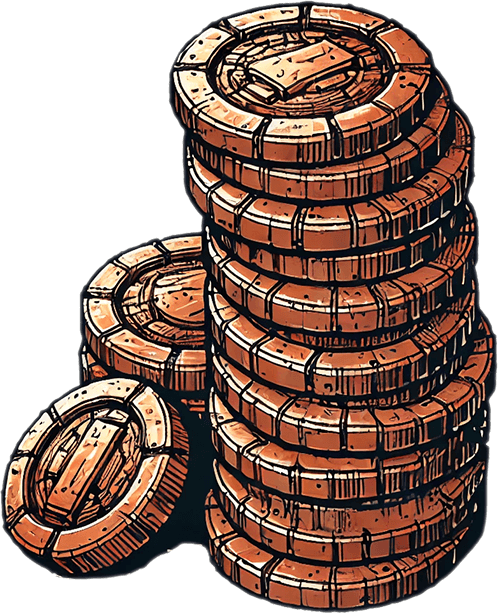
- Exploration: The town features a bell system which can be used to gather people. Don't be afraid to use it if you wish to gather a group for your ventures!
- Community Shoppe: The town has a community shop. Here, players can buy and sell items from each other. The community shop can be freely perused by anyone, but only a citizen may sell through it.
- Coins: Like many other places on Toril, coins are an important resource for getting what you want. For newly arrived characters there are many different ways to earn your first coins.
- Sell resources to the depot: The community shop features a storage depot that purchases and sells essential materials at set prices. This can be a good way to make consistent coin.
- Contribute to developments: There are often construction projects or player-built structures that require help to finish. In many cases, characters might offer payment in exchange for your help on these developments.
- Flotsam and Jetsam: Owing to the many shipwrecks upon Narumer, much flotsam and jetsam can often be found close to the beaches where your character first arrives. These can be a good source of various trinkets and baubles which can be sold to merchants or other characters.
- Time: Time on Haze advances at a rate of 27 real-world minutes for 1 in-game hour.
- Chat commands and macros: Haze features many useful chat commands. Some are more essential than others. Use built-in macro feature to easily access these commands.
- Roleplay first, gameplay second: Don't hesitate to interact with other characters—after all, Haze is a roleplaying environment. When in doubt, use your curiosity and questions as fuels for your roleplay. Don't go blind staring at numbers and gameplay mechanics!
- Use our Discord channel for questions and answers: Even veteran players discover new things every day. Feel free to visit our Discord server if you have any questions or if you want to concept a character with the help of others.
¶ So... what now?
Now that you've read this primer on Haze: Saltborne, you're ready to jump right in.
- Purchase the game!
- Connect to the Haze in the server list.
- Read the pages in the sidebar to find out more about our custom spells, systems and more.
- Read up more carefully on our rules of conduct and community standards.
- Join our Discord! We are a friendly and welcoming community, and are always happy to help and answer any questions you have, or help you concept a character.

¶ Feedback
If you have feedback on this guide, or the content within, please do not hesitate to reach out to us on Discord and leave your feedback.
This Traveler's Guide to Narumer was written and designed by next of kin, and is derivative of thebountifulgod's original Traveler's Guide to Narumer.